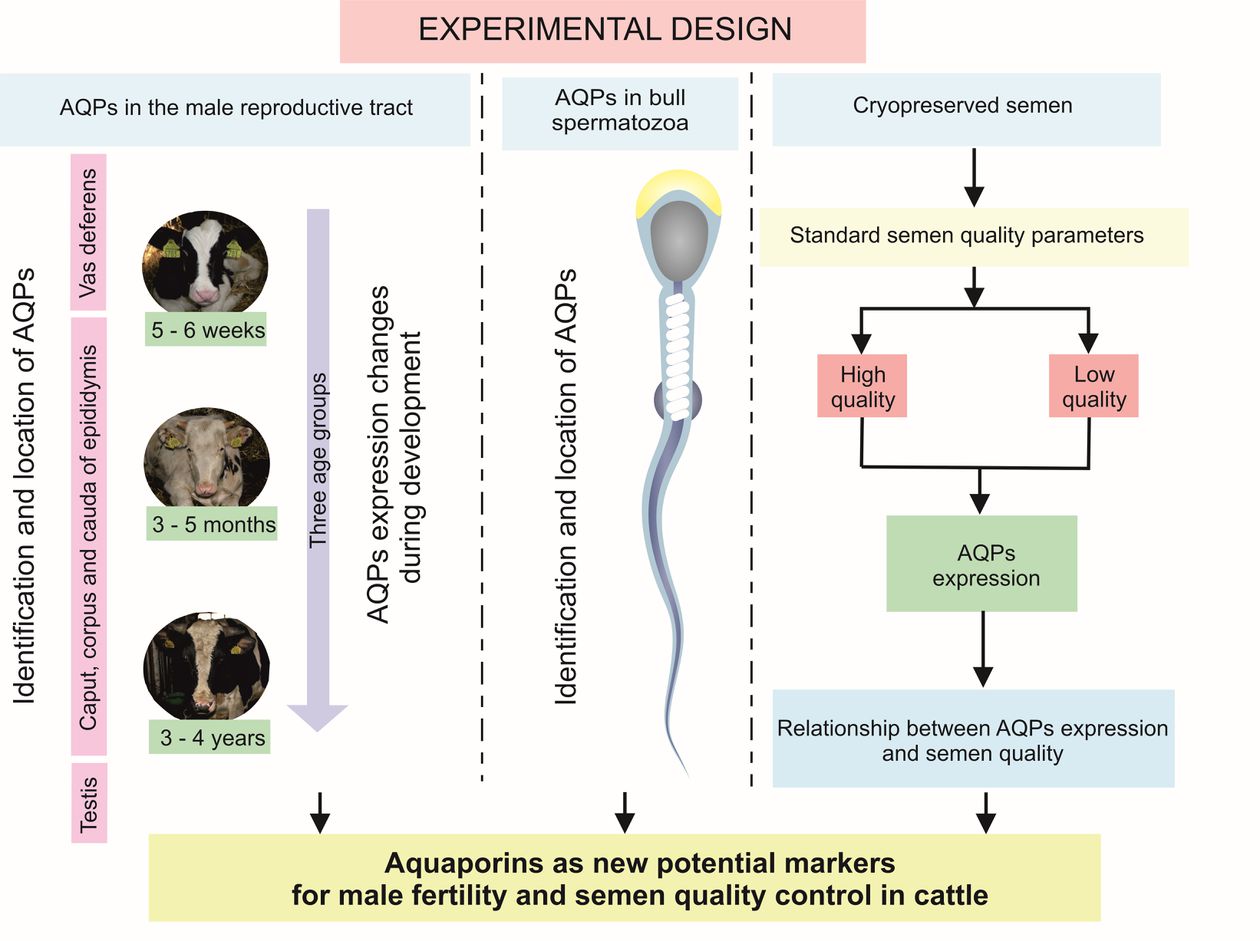W poszukiwaniu nowych markerów płodności samców u bydła. Ekspresja akwaporyn w narządach rozrodczych i plemnikach u buhajów (Bos taurus)
Maintaining proper fluid homeostasis within the male reproductive system is one of the key elements conditioning proper development, maturation and function of vertebrate male germ cells. Water channels discovered in the 90s known today as aquaporins (AQPs) undoubtedly play an important role in this area, hence the analysis of their location and expression in male reproductive organs and sperm not only arouse great interest, but also provide high hopes for finding new opportunities in increasing fertility and treating male infertility. It is well known that semen analysis is a basic test that is used to determine male fertility. However, currently recommended methods in animals include determination of rather superficial parameters, which are not sufficient to fully assess the functional status of spermatozoa. Hence, semen of lower quality is often used for animal breeding, including cattle, which reduces the effectiveness of fertilization, and males with reduced fertility are often not detected sufficiently early and disqualified from breeding. Modern research methods allow not only to identify and analyze AQP expression in sperm, but also conduct an extended metabolomic analysis of semen.
Semen cryopreservation is one of the most important techniques used in reproduction of animals. According to recent studies, the key element determining survival and functional status of spermatozoa after cryopreservation is the correct level of AQPs and other physicochemical markers. In response to contemporary challenges regarding to problems of male fertility was prepared innovatory project, which main aim is to identify AQPs location and to analyze their expression in bovine male reproductive tract cells, as well as physicochemical markers as a new moderators’ for semen quality control. As a result of the study, the bull will be the first male where a comprehensive analysis will be performed of all AQP distribution in male reproductive tract and changes in their expression as they grow and develop. On this basis, it will be possible to formulate the potential role of each of the analyzed AQPs. The results obtained in this way will not only provide new data in this field but will also allow a deeper understanding of the basis of many processes and their mechanisms of action occurring within the male reproductive system. In the course of the study, an analysis of the expression of all potentially localized AQPs in bull spermatozoa will also be conducted, and the specific analysis of physicochemical markers of cryopreserved semen will allow to determine their relationship with individual semen parameters after the freeze-thawing process. The results obtained in this manner will allow the selection of the measurement of AQPs and physicochemical markers as potential characteristics of cryopreserved sperm quality.
In animal husbandry practice, despite high functional values and high genetic evaluation, bulls are often characterized by low fertility, the causes of which remain elusive. The final results of the implementation of all aims and assumptions in the proposed project will allow not only a completely “new view” of the bull and indication of new factors that may significantly affect its fertility, but also the selection of new more sensitive parameters enabling an extended analysis of the quality of cryopreserved semen. In addition, it should be stated that in Poland Cattle Farming is one of the mains agricultural sector, for this reason, value of this project will be very high, because, obtained deep scientific knowledge will lead to the progress of this industry.
Project research objective and hypotheses
Analysis of the location and expression of individual AQPs in the bovine male reproductive tract and determination of their potential role in the development and production of high-quality semen, along with the analysis of these proteins and physicochemical markers in cryopreserved semen, creates new and broad possibilities. In the future, they may become an essential and even indispensable element in predicting reproductive potential of the bull and fully assessing the quality of cryopreserved semen. Therefore, the proposed project aims to implement three main research tasks, (1) location and expression analysis of all potentially localized AQPs in the reproductive system in cattle and analysis of changes in their expression during development; (2) detailed localization of all potentially occurring AQPs in bovine spermatozoa, (3) the search for the relationship between the expression of AQPs in spermatozoa and the content of physicochemical markers in semen and the quality of cryopreserved sperm. The implementation of these tasks will allow testing the research hypothesis, which assumes that (1) aquaporins in cattle play an important role in the proper maintenance of fluid homeostasis of the male reproductive system, which will be reflected by the location of 10 AQPs there, and expression of some of them will change with growth and development, (2) expression of aquaporins located in spermatozoa and the free amino and fatty acids profile, as well as biogenic amines, cholesterol and malondialdehyde concentration in sperm are related to semen quality.


Informacje szczegółowe
- Akronim projektu:
- AQPs
- Program finansujący:
- INNY
- Instytucja:
- Narodowe Centrum Nauki (NCN) (National Science Centre)
- Porozumienie:
- 2021/43/B/NZ9/00204 z dnia 2022-06-27
- Okres realizacji:
- 2022-06-27 - 2025-06-26
- Kierownik zespołu badawczego:
- dr hab. inż. Katarzyna Maria Michałek
- Członkowie zespołu:
-
- Stypendysta NCN mgr inż. Patrycja Oberska
- Wykonawca/Naukowiec dr inż. Marta Marynowska
- Wykonawca/Naukowiec dr inż Sławomir Zych
- Wykonawca/Naukowiec dr hab. inż. prof ZUT Dariusz Gączarzewicz
- Członek zespołu/Naukowiec dr hab. inż. prof URK Maciej Murawski
- Członek zespołu dr inż. Andrzej Syczewski
- Członek zespołu/Naukowiec dr inż. Marta Grabowska
- Członek zespołu/Naukowiec Prof. dr Elena Bartkiene
- Członek zespołu/Naukowiec dr Maria Suciu
- Realizowany w:
- Wydział Biotechnologii i Hodowli Zwierząt
- Instytucje zewnętrzne
biorące udział w projekcie: -
- Lithuanian University of Health Sciences (Litwa)
- Babeș-Bolyai University (Rumunia)
- Wartość projektu:
- 1 339 072.00 PLN
- Typ zgłoszenia:
- Inny
- Pochodzenie:
- Projekt krajowy
- Weryfikacja:
- Brak weryfikacji
wyświetlono 80 razy
